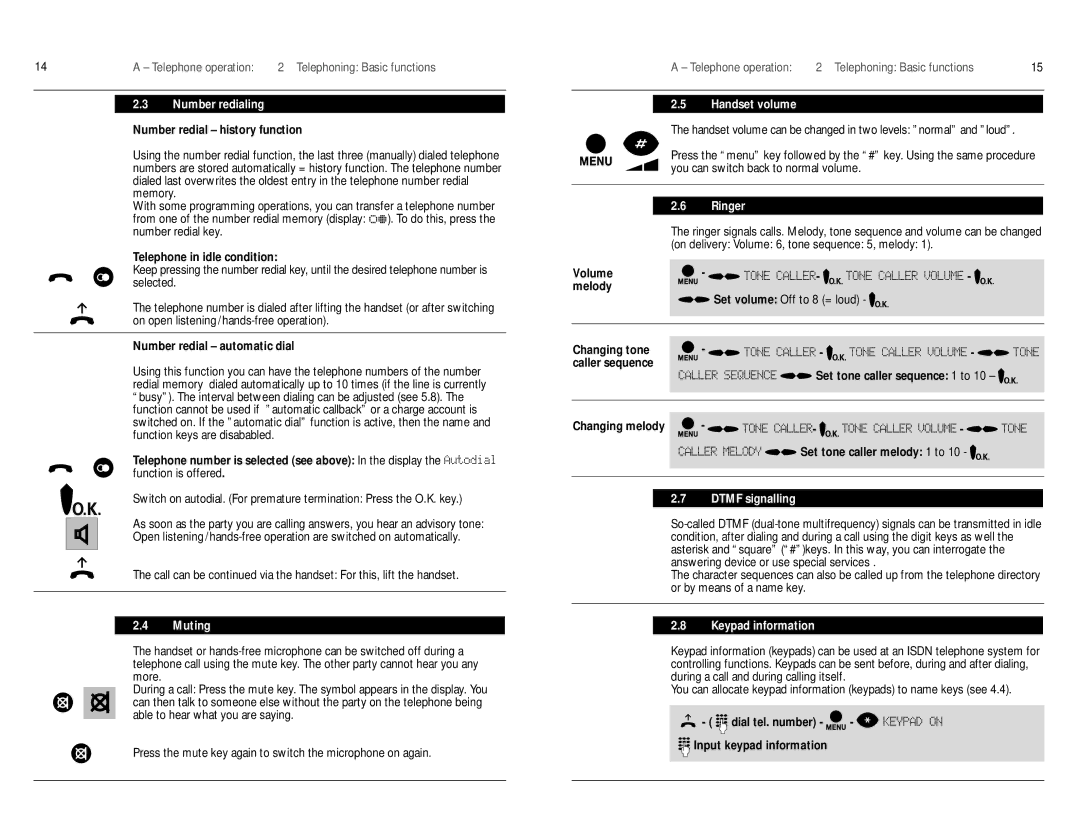
14 | A – Telephone operation: | 2 Telephoning: Basic functions |
2.3Number redialing Number redial – history function
Using the number redial function, the last three (manually) dialed telephone numbers are stored automatically = history function. The telephone number dialed last overwrites the oldest entry in the telephone number redial memory.
With some programming operations, you can transfer a telephone number
from one of the number redial memory (display: ). To do this, press the number redial key.
Telephone in idle condition:
Keep pressing the number redial key, until the desired telephone number is selected.
The telephone number is dialed after lifting the handset (or after switching on open
Number redial – automatic dial
Using this function you can have the telephone numbers of the number redial memory dialed automatically up to 10 times (if the line is currently “busy”). The interval between dialing can be adjusted (see 5.8). The function cannot be used if ”automatic callback” or a charge account is switched on. If the ”automatic dial” function is active, then the name and function keys are disababled.
Telephone number is selected (see above): In the display the function is offered.
Switch on autodial. (For premature termination: Press the O.K. key.)
As soon as the party you are calling answers, you hear an advisory tone: Open
The call can be continued via the handset: For this, lift the handset.
2.4Muting
The handset or
During a call: Press the mute key. The symbol appears in the display. You can then talk to someone else without the party on the telephone being able to hear what you are saying.
Press the mute key again to switch the microphone on again.
A – Telephone operation: | 2 Telephoning: Basic functions | 15 |
2.5Handset volume
The handset volume can be changed in two levels: ”normal” and ”loud”.
Press the “menu” key followed by the “#” key. Using the same procedure you can switch back to normal volume.
2.6Ringer
The ringer signals calls. Melody, tone sequence and volume can be changed (on delivery: Volume: 6, tone sequence: 5, melody: 1).
Volume | - | - | - |
melody |
| Set volume: Off to 8 (= loud) - |
|
|
|
| |
|
|
|
|
|
|
|
|
|
|
|
|
Changing tone | - | - | - |
caller sequence |
| Set tone caller sequence: 1 to 10 – | |
|
| ||
|
|
|
|
|
|
|
|
|
|
|
|
Changing melody | - | - | - |
|
| Set tone caller melody: 1 to 10 - | |
|
|
|
|
|
|
|
|
2.7DTMF signalling
The character sequences can also be called up from the telephone directory or by means of a name key.
2.8Keypad information
Keypad information (keypads) can be used at an ISDN telephone system for controlling functions. Keypads can be sent before, during and after dialing, during a call and during calling itself.
You can allocate keypad information (keypads) to name keys (see 4.4).
-( ![]()
![]()
![]() dial tel. number) -
dial tel. number) - ![]() -
- ![]()
![]()
![]()
![]() Input keypad information
Input keypad information
